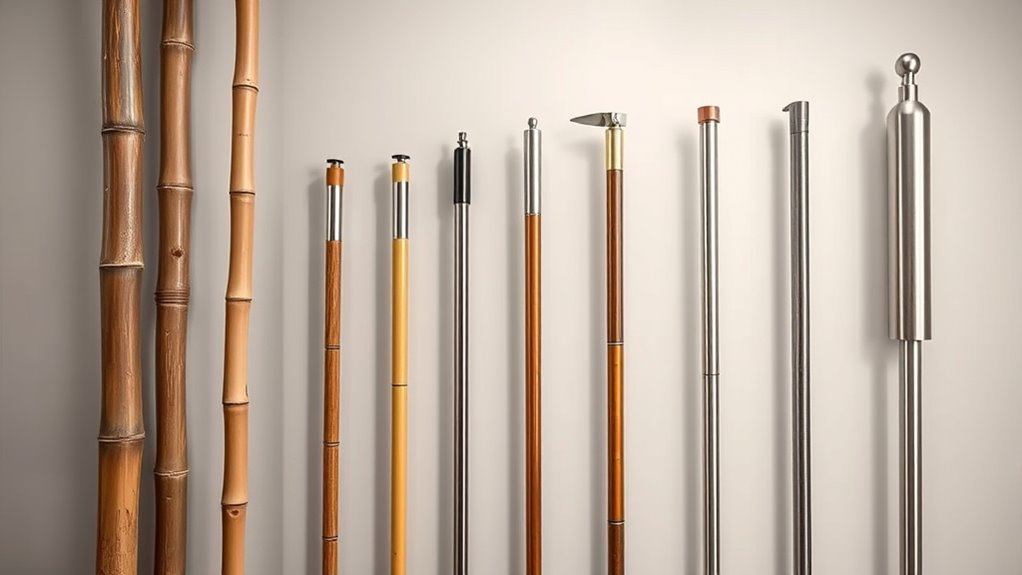The evolution of poles from simple bamboo sticks to advanced aerospace aluminum showcases human ingenuity and technological progress. Starting with natural materials like bamboo and wood, we moved to stronger metals like iron and steel during the Industrial Revolution. Today, innovative composites and aluminum alloys offer lightweight, durable solutions designed for complex infrastructure. If you continue exploring, you’ll discover how material science and manufacturing have shaped poles for modern needs across industries.
Key Takeaways
- Early poles used natural materials like bamboo and wood for basic functions with limited durability.
- Metal poles, primarily iron and steel, replaced natural materials for better strength and longevity.
- Industrial innovations introduced mass production, galvanization, and improved manufacturing techniques for poles.
- Modern materials such as aluminum alloys and composites enhance pole strength, weight, and resistance to environmental factors.
- Contemporary pole engineering incorporates advanced materials like aerospace aluminum for maximum durability and safety.

Have you ever wondered how poles have evolved over time? It’s fascinating to see how they’ve transformed from simple natural materials into high-tech, engineered components. Early poles, like bamboo and wood, served basic purposes but lacked the material durability needed for demanding tasks. Over centuries, humans began experimenting with different substances, seeking stronger, lighter, and more reliable options. The journey from natural to synthetic and advanced alloys reflects not just technological progress but also the refinement of manufacturing processes.
Initially, poles made from bamboo and wood were accessible and easy to work with, but their material durability was limited. These natural materials often suffered from rot, pests, and weathering, which meant they needed frequent replacement. As civilizations advanced, so did their understanding of materials. Metal poles, such as iron and steel, emerged, offering improved strength and longevity. These metals provided better resistance to environmental factors, but their manufacturing processes were often labor-intensive and required specialized skills. Forging, casting, and welding became standard techniques, pushing the limits of what could be achieved with available technology.
The Industrial Revolution marked a turning point, bringing mass production and mechanization into pole manufacturing. Steel poles, particularly, gained popularity because they combined good material durability with efficient manufacturing processes. Continuous casting, rolling, and galvanization techniques improved the quality and lifespan of these poles, making them suitable for infrastructure projects like power lines and telecommunication towers. As production methods advanced, poles could be produced at scale, with consistent quality and reduced costs.
With the advent of modern materials, the focus shifted toward lighter, stronger, and more corrosion-resistant options. Aluminum alloys entered the scene, valued for their excellent strength-to-weight ratio and resistance to environmental damage. Manufacturing processes like extrusion and precision machining enabled the production of complex pole designs that were both durable and lightweight. Later, the development of composite materials, such as fiberglass and carbon fiber, further revolutionized pole design. These composites offer superior material durability, resisting weathering and mechanical stress better than traditional metals, while also allowing for innovative manufacturing techniques like pultrusion and resin infusion.
Today, the evolution from bamboo to aerospace aluminum exemplifies the relentless pursuit of better materials and manufacturing processes. Modern poles are not just functional—they are engineered for maximum durability, efficiency, and safety. The continuous improvements in materials science and manufacturing technology ensure that poles can withstand the harshest environments while serving our increasingly complex infrastructure needs. This evolution reflects human ingenuity, driven by the desire to create poles that are stronger, lighter, and more resilient than ever before.
Frequently Asked Questions
How Does Pole Manufacturing Impact Environmental Sustainability?
You might wonder how pole manufacturing affects environmental sustainability. When you choose poles made from biodegradable materials, you help reduce waste and pollution. Additionally, by focusing on carbon footprint reduction during production, you lessen greenhouse gas emissions. These efforts promote eco-friendly practices, ensuring that pole manufacturing supports a healthier planet. Your choices in sustainable materials and processes make a positive difference for environmental conservation and future generations.
What Are Future Innovations in Pole Material Technology?
Future innovations in pole material technology include biodegradable composites that reduce environmental impact and smart pole sensors for enhanced safety and maintenance. You’ll see more sustainable options replacing traditional materials, making poles eco-friendly and durable. Smart sensors will enable real-time monitoring, improving infrastructure management. These advancements will help you choose poles that are not only innovative but also environmentally responsible, ensuring safer, smarter, and greener urban landscapes.
How Do Poles Influence Modern Architectural Design?
Think of poles as the backbone of modern architecture, shaping both form and function. You see how pole aesthetics influence building styles, creating sleek lines or dramatic structures. Advanced pole installation techniques guarantee stability and safety, letting architects push creative boundaries. These poles are more than supports; they’re design elements that blend strength with beauty, transforming skylines and defining spaces. Without them, today’s innovative architecture wouldn’t stand tall.
What Safety Standards Govern Pole Durability and Performance?
You should know that safety standards for pole durability and performance focus on preventing pole corrosion and guaranteeing reliable strength. Certification processes, such as pole certification, verify that poles meet these standards, guaranteeing safety and longevity. Regular inspections and adherence to industry guidelines help you mitigate risks associated with corrosion and material degradation. Following these standards ensures your poles withstand environmental stresses and maintain their structural integrity over time.
How Is Pole Recycling and Reuse Evolving Globally?
Recycling and reuse of poles are blossoming like a garden in full bloom. You’re seeing a shift towards urban mining, where materials are reclaimed from old poles instead of digging new resources. This aligns with the circular economy, reducing waste and conserving resources. Globally, innovative methods are making pole recycling more efficient, helping industries turn scrap into valuable assets, and fostering sustainable practices that keep our planet green.
Conclusion
As you’ve seen, the journey from bamboo to aerospace aluminum is like watching a humble seed grow into a soaring eagle. Each material tells a story of innovation and progress, shaping the poles that support your world. Remember, every step in this evolution is a brushstroke on the grand canvas of human ingenuity. So, next time you glimpse a pole, think of it as a silent witness to centuries of dreams reaching for the sky.


















